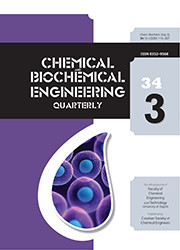Integration of sonication (US) with electrokinetic (EK) oxidation was studied for the treatment of a saline oily wastewater, as well as the effect of operating parameters, including pH, voltage, electrode distance (ED), sonication power, and reaction time on COD removal. A COD removal of 98 % was observed for the sono-electrokinetic (SEK) process with an applied voltage of 2.5 V, US power of 300 W, initial COD concentration of 3850 mg L–1, and reaction time of 9 h. The efficiency of SEK over sonication alone and EK oxidation alone was also confirmed with a higher pseudo-first-order reaction rate constant of 0.43 h–1, compared to values of 0.13 and 0.01 for alternative processes. In addition, the biodegradability of effluent was improved based on average oxidation state (AOS) and carbon oxidation state (COS) analysis. Oxygen consumption rate inhibition, dehydrogenase activity inhibition, and growth rate inhibition methods demonstrated the low toxicity of effluent (12–15 %) compared to influent. The current work indicated that SEK is a reliable and efficient technology for the treatment of saline oily wastewaters containing recalcitrant aromatic organics.
Sažetak
Dio od

 Chemical & biochemical engineering quarterly : the international publication of "Kemija u industriji" : the official journal of Croatian Society of Chemical Engineers, Faculty of Chemical Engineering and Technology University of Zagreb, Slovenian Chemical Society, and Austrian Association of Bioprocess Technology : 34,3(2020) / co-editors-in-chief M. Rogošić, B. Zelić.
Chemical & biochemical engineering quarterly : the international publication of "Kemija u industriji" : the official journal of Croatian Society of Chemical Engineers, Faculty of Chemical Engineering and Technology University of Zagreb, Slovenian Chemical Society, and Austrian Association of Bioprocess Technology : 34,3(2020) / co-editors-in-chief M. Rogošić, B. Zelić.